The Friedland transit camp from 1945 until today.
Historical milestones.
Since it was founded in 1945, Friedland transit camp has processed over four million people arriving in the Federal Republic of Germany. The transit camp (Grenzdurchgangslager – GDL) near Göttingen has been a reception centre for refugees and expellees after the Second World War, for released prisoners of war (POWs) and displaced persons (DPs), for ethnic German immigrants, and for people seeking refuge from many parts of the world. Today, it is the initial reception centre for ethnic German and Jewish immigrants from the former Soviet Union as well as asylum seekers and refugees under resettlement and humanitarian intake programmes.
Friedland transit camp is established as a result of the Second World War and the migration of millions of people when the hostilities cease. The British Military Government sets up transit camps to register these masses of people and control their onward movement. The Friedland camp goes into operation on 20 September 1945.
To begin with, the arrivals are primarily refugees and expellees from the territories to the east of the Rivers Oder and Neisse. But war evacuees as well as POWs released from Western Allied captivity also pass through the Friedland camp on their way back to their former homes or their families in the various zones of occupation. Between 1945 and 1949, approximately 1.7 million people pass through the camp.
Few arrivals stay longer than one or two days. However, from 1949 to 1952, Friedland is also a residential camp for displaced persons; from 1947 to 1951, and again between 1960 and 1963, it serves as a reception centre for unaccompanied young men from the Soviet occupation zone / East Germany.
With the arrival of the last German POWs from the Soviet Union here in 1953/54 and 1955/56, the Friedland camp gains a national and international profile. The so-called Heimkehr der Zehntausend (Return of the 10,000) is a major media event in the early years of West Germany. Friedland becomes the emotionally-laden focus for many people’s hopes and wishes and, at the same time, a setting for orchestrated political events in the Cold War.
“Operation Link” in March 1950 marks the start of the intake of ethnic German immigrants. Since then, over two million ethnic German immigrants have been registered in Friedland.
From the mid-1950s to the end of the 1980’s, the Friedland transit camp has also temporarily taken in international refugees on a number of occasions. These include refugees from Hungary in 1956/57 after the democratic uprising there was crushed; Chilean refugees in 1974 after the coup d’etat against Salvador Allende’s democratically elected government; and Vietnamese “boat people” since 1978. They come to Western Germany as refugees on humanitarian intake programmes. In the 1970s and 1980s, due to the lack of space in the responsible reception facilities, Friedland also takes in asylum seekers from various countries for a time.
The drop in the numbers of ethnic German immigrants changes the nature of the Friedland facility. It gradually turns from a reception centre for Germans into a centre for people from all over the world.
From 1 July 1998 until 30 September 2000 and again since 1 March 2004, the transit camp has also functioned as the Lower Saxony reception centre for Jewish immigrants from the former Soviet Union.
In 2009/2010, 2.500 Iraqi refugees entering Germany under a humanitarian intake programme are accommodated in the Friedland transit camp. Since September 2012, refugees on the UNHCR resettlement programme have regularly arrived in Friedland. On 1 January 2011, the Friedland camp is also officially named as one of the initial reception centres for asylum seekers in Lower Saxony. In 2015, it is responsible for refugees from Afghanistan, Eritrea, Iraq, Lebanon, Pakistan, the Russian Federation, Syria, Turkey and Vietnam.
After the end of the Cold War, the Friedland transit camp no longer mainly reflects the long-term consequences of the Second World War. Instead, it becomes a mirror of today’s global flashpoints.
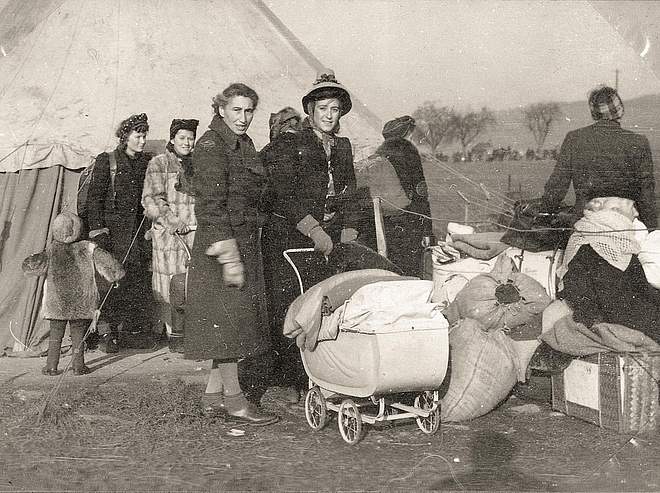
1945
Refugees in the Friedland transit camp, 1945
After the Second World War, Friedland lies in the British zone of occupation in Germany, close to both the American and Soviet zones. The camp’s core task is to register the many arrivals crossing the borders here in various directions. From 1945 to 1949 alone, 1.7 million people pass through the camp. To begin with, the largest groups are refugees from the former German territories to the east of the Rivers Oder and Neisse. From 1946, though, many transports of expellees arrive at the camp – especially from Poland. Photographer unknown, Museum Friedland
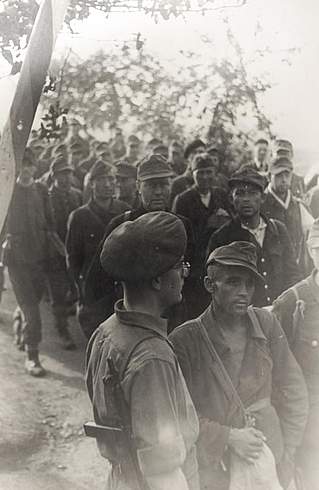
1946
Released POWs crossing the zone border near Friedland, 1.4.1949
Above all, war evacuees and POWs released from Western Allied captivity pass through Friedland to their former homes now in the Soviet occupation zone. In August 1946, the first transports with released POWs arrive from the Soviet Union. Photographer: Hans Pusen, Historisches Museum Hannover
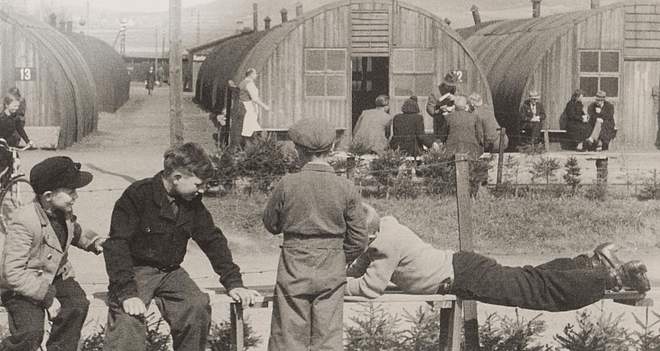
1950
Children outside Nissan huts in the Friedland camp, c. 1950
Between 1948 and 1956, Friedland is a main hub for West Germany to organise exchanges of children to and from the states in eastern, central-eastern and south-eastern Europe. The children’s families have been scattered during the war. The Tracing Services and authorities on both sides of the “Iron Curtain” cooperate in reuniting the children with their families. Photographer: Rudolf Lindemann, DRK-Suchdienst München
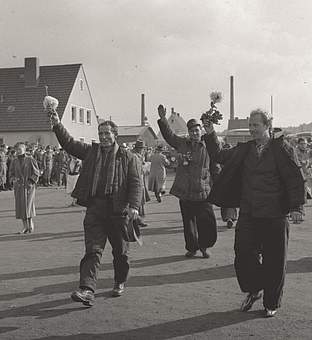
1955
Reception of POWS released from the Soviet Union, 17.10.1955
Between 1953 and 1956, the last German POWs are released from the Soviet Union. West Germany welcomes them in the Friedland camp. Their arrival is a major political and social event. For decades, this crucially influences the camp’s image as a “Gateway to Freedom”. For a long time, little attention is paid to the fact that the returnees include some charged with committing serious war crimes. Photographer: Rolf Unterberg, Bundesarchiv B 145 Bild-00011563
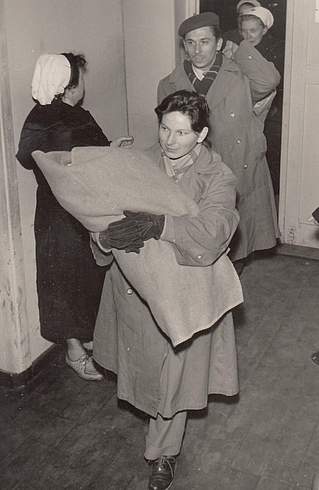
1956
Refugees from Hungary arriving in the transit camp, 1956
After the Hungarian uprising in 1956 is crushed, 13,000 people flee to West Germany. As “fighters against Communism”, they are granted asylum and can stay permanently. Initially, 3,500 of them are accommodated in Friedland. Photographer: Rudolf Kluwe, Städtisches Museum Göttingen
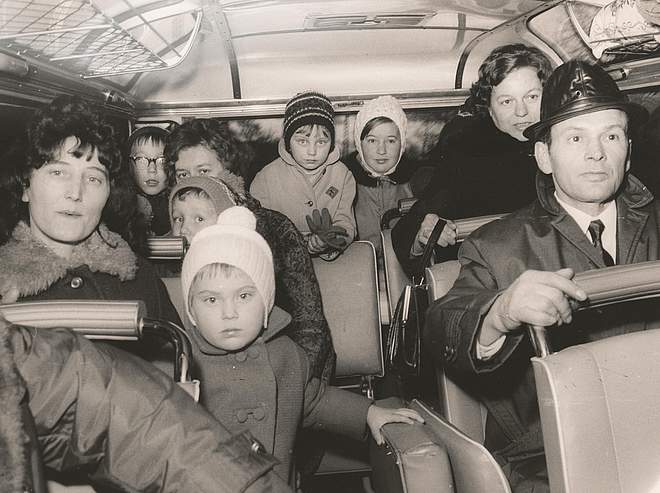
1957
Ethnic German immigrants from Poland going to the transit camp from Friedland Station, c. 1957
The largest groups in Friedland comprise ethnic German immigrants from eastern and central-eastern Europe. To be granted ethnic German immigrant status, they have to prove their “Germanness” , that they come from countries under Soviet influence, and have family members in the Federal Republic of Germany. Until 1992, most ethnic German immigrants come from Poland – over one million in total. Photographer: Fritz Paul, Museum Friedland
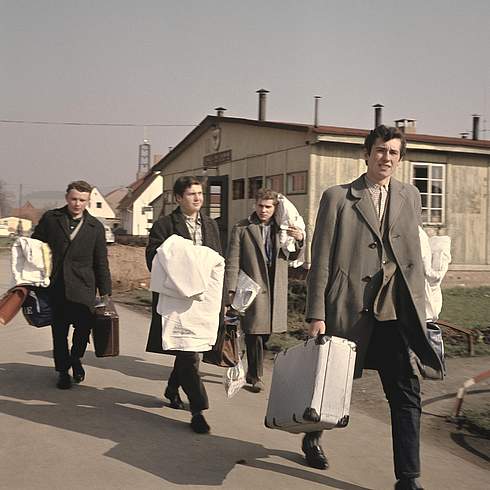
1960
Young East German refugees in the Friedland transit camp, 1960
At times after 1959, fewer ethnic German immigrants can leave Poland. From 1960 to 1963, with many beds in the Friedland camp remaining unoccupied, a camp is set up there for young men from East Germany. During those years, the youth camp looks after over 22,000 East German refugees. Photographer: Klaus Heirler, picture-alliance/dpa
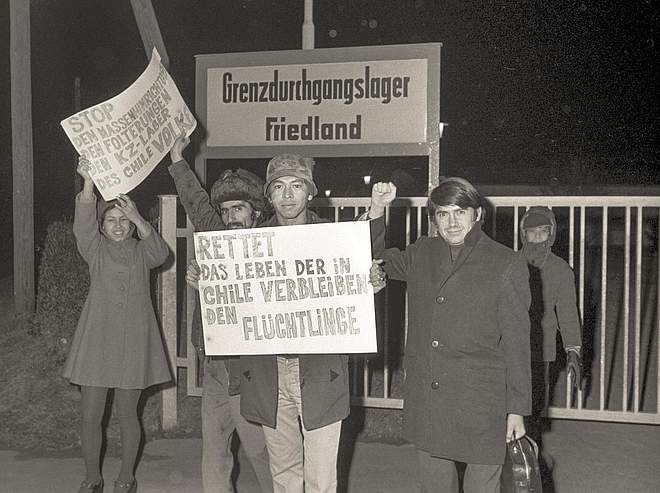
1974
Arrival of Chilean refugees at the Friedland camp, 10.1.1974
On 11.9.1973, a violent coup d’état in Chile topples Salvador Allende’s socialist government. Allende’s supporters are facing prison, torture and execution. After considerable hesitation, the West German government decides to take in a number of Chilean refugees. Politically, the humanitarian intake programme is controversial – with some suspecting that the refugees include “professional revolutionaries”. West Germany takes in a total of 4,000 Chilean refugees. In January 1974, seventy of them are accommodated in the Friedland camp. Photographer: Wolfgang Weihs, picture alliance
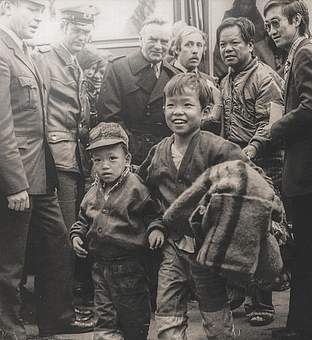
1978
„Boat People“ aus Vietnam finden Zuflucht in Friedland, 3.12.1978
Über eine Million Menschen fliehen ab 1978 auf dem Seeweg aus dem kommunistisch regierten Vietnam. Die Bundesrepublik nimmt in den 1970er und 1980er Jahren rund 35.000 dieser „Boat People“ auf. Über 4.500 von ihnen durchlaufen Friedland. Sämtliche politischen Parteien befürworten die Aufnahme; innerhalb der Bevölkerung ist die Unterstützung groß. In Zeiten des Kalten Krieges sind die Flüchtlinge aus dem kommunistischen Vietnam besonders willkommen. Fotograf: Kurt Strumpf, Associated Press
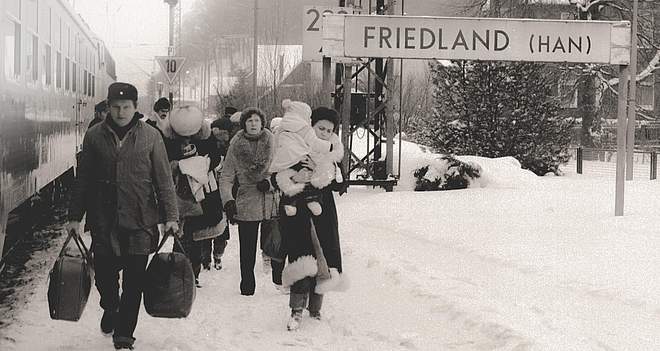
1981
Ethnic German immigrants from Poland at Friedland Station, 21.12.1981
From 1970 on, the East-West conflict is eased by various internationally negotiated agreements. The Polish People’s Republic makes it easier to obtain exit visas. Many ethnic German immigrants reach Friedland by train. After the mandatory registration process, they travel on to their new homes in places throughout West Germany. Photographer: Karlheinz Otto, Museum Friedland
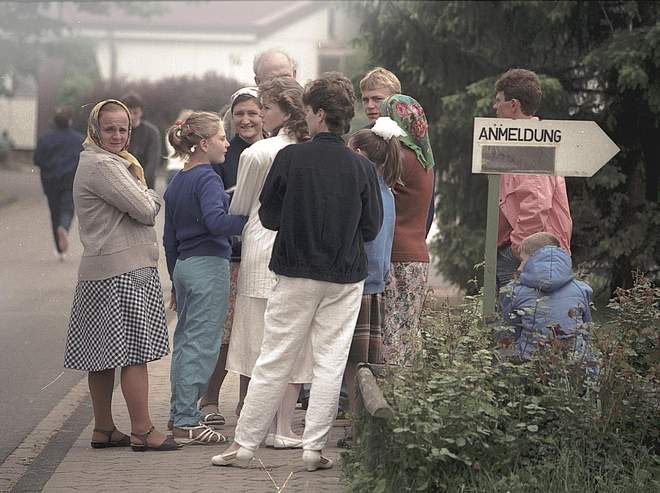
1988
Family from Tajikistan waiting to register, June 1988
The end of the East-West conflict has a tangible impact on the Friedland camp. Many people seize the chance offered by the open borders to come to West Germany as ethnic German immigrants. From 1987 to 1990, the Friedland transit camp is completely overcrowded. The management has to limit its operations to the most essential, accommodating many arrivals outside the camp. Photographer unknown, Federal Archives, Image F079036-0007
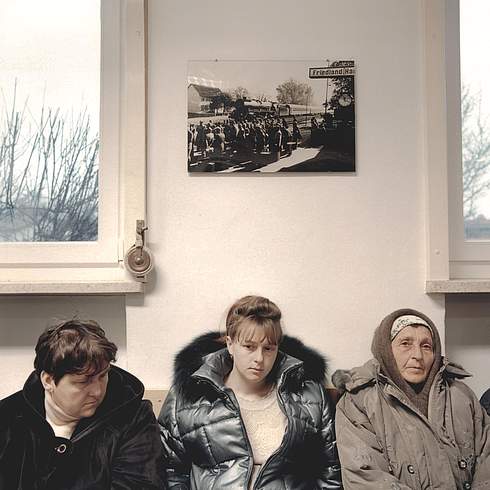
2001
Ethnic German immigrants from the former Soviet Union waiting to register in the transit camp, 2001
From 1990 to 2012, nearly all arrivals at the Friedland transit camp are from the Soviet Union and its successor states. The largest group are ethnic German immigrants; the remainder are Jewish immigrants. From 2000, Friedland is the sole initial reception centre for ethnic German immigrants in Germany. Photographer: Stefan Volk | laif
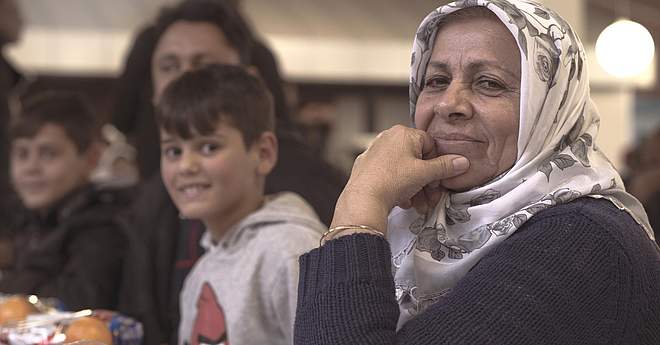
2011
Family from Kosovo at the Christmas celebrations in the transit camp, 9.12.2014
From 2011, Friedland transit camp is also an initial reception centre for asylum seekers. It is responsible for refugees from Afghanistan, Eritrea, Iraq, Lebanon, Pakistan, the Russian Federation, Syria, Turkey and Vietnam. In this way, the work of the transit camp directly mirrors today’s global flashpoints. Photographer: Swen Pförtner, picture alliance/dpa
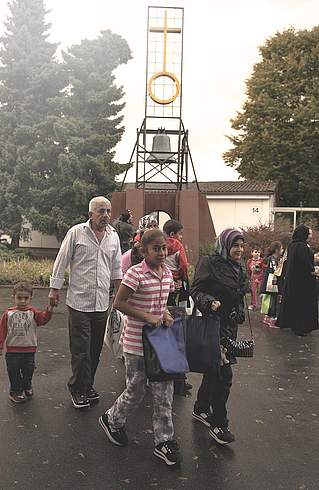
2015
Syrian refugees on arrival by the Friedland bell, 11.9.2013
Every day, people from many countries arrive in the Friedland camp. They are fleeing from war and civil war, from persecution and suppression, from poverty and the lack of any future prospects. Those recognised as entitled to asylum or registered on humanitarian intake programmes – such as, for example, some Syrian refugees – are granted long-term residency in Germany. For the others, their future is uncertain. Photographer: Swen Pförtner, picture alliance/dpa
